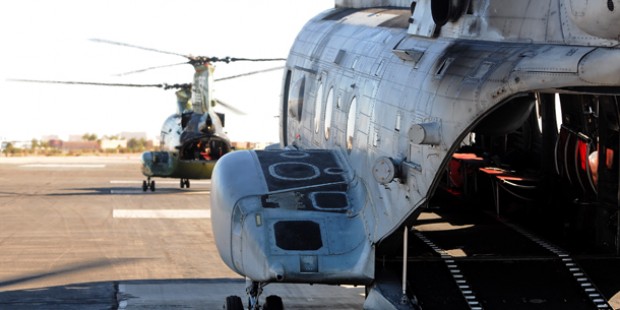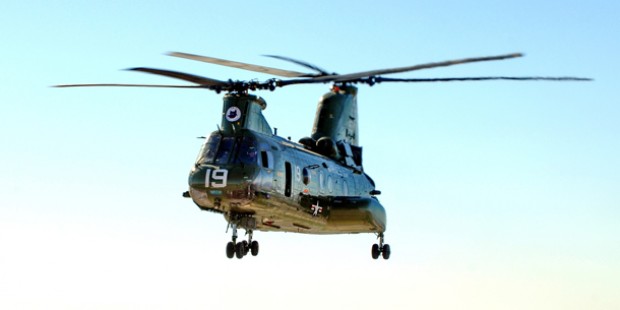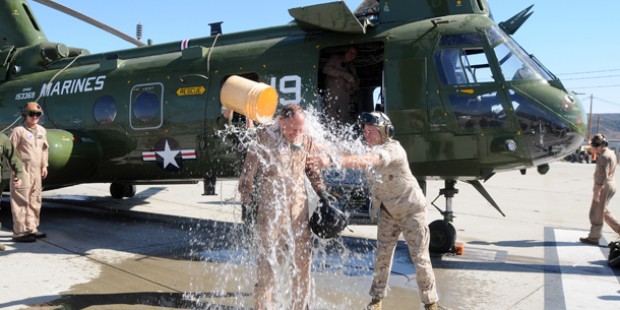Men become attached, even grow to love certain non-human things, like a Cowboy to his horse, it was the same with the U.S. Marines and their Boeing Vertol CH-46 (Sea Knight) helicopters.
First procured by the Marine Corps back in 1961, it was to meet their medium-lift requirements. It first flew in August in 1962 and was designated as the CH-46A. By November of 1964, the Marine CH-46A and the U.S. Navy’s UH-46A was introduced to the Fleet.
For the next 50 years, thousands of Marines would step foot on these beast of burden. From flying into hot landing zones (LZ’s) to fighting wildfires in California, from Medical evacuations in combat to Humanitarian evacuations around the world, the CH-46 was always ready for the Marines.
Lovingly nick named the “Phrog” by the Marines (Wondering, why the name “Phrog”?, if you look at the front of the aircraft, it resembles a sitting frog, thus the name), the Sea Knight has been used in all U.S. Marine combat and peacetime environments since its introduction. By 2014, it was still regularly flown by the Marines (The U.S. Navy retired theirs in September 2004), its longevity as a reliable airframe has led to such mantras as “phrogs phorever” and “never trust a helicopter under 30”.
The “Purple Foxes” of Marine Medium Helicopter Squadron, HMM-364 (now VMM-364, due to their transition to the Bell Boeing MV-22 Osprey) started flying the CH-46 in 1967 and they were the last active duty (fleet deployable) Marine squadron to fly the CH-46, now with a “E” designation.
During the summer and fall of 2014, the Purple Foxes were slowly flying their old friends to the Davis-Monthan Air Force Base in Tucson, Arizona, where ARMAG (Aerospace Maintenance and Regeneration Group) is located. Also known as “The Bone Yard”, 2600 acres of desert land, where most U.S. military planes go for retirement. Here the planes are stored for replacement parts or are slated for destruction.
On October 27th and 28th, 2014, I had the honor to fly with the Purple Foxes for their last delivery of aircraft #06, this CH-46E was flown by Captain Rick Hill and Captain Matt Schmitt, with Staff Sergeant Derek Burleson & Sergeant John Kirk VI as the flight crew.
We were being escorted by another CH-46E being flown by the Commanding Officer of the Purple Foxes, Lt. Colonel Paul Kopacz and Major Eric Landblom, the Maintenance Officer for HMM-364, along with crew members, Staff Sergeant Ryan St. Antoine and Sergeant Carmen Zangari. This plane had been repainted in the colors of her Vietnam days in Green with Black. She was to escort #06 to Davis-Monthan AFB, and then fly us all back to Marine Corps Air Station (MCAS) Camp Pendleton, California.
Starting with a briefing for the flight, I was met and welcomed with open arms by the crew, I would be flying with, and being a former Marine Infantryman, it was to be a nostalgic final flight for myself, as I had flown on many CH-46’s during my time in the Corps. A Captain Gibson gave the weather report to the two crews, and stated “it was promising to be a beautiful day for flying”.
We took off from MCAS Camp Pendleton with an itinerary to fly to the airport in Imperial, California and refuel, and then fly non-stop to Davis-Monthan AFB. The flight took approximately 4.5 hours. The entire flight was smooth, and the flying conditions were perfect. Flying over the high mountains of eastern San Diego County and then dropping down into the desert of southeastern California, I watched the Marine crew as they either performed their duties, or were looking out over the ever changing scenery. I was thinking back to my days of flying in the CH-46, and wondered if they were doing the same.
I asked Captain Schmitt, who has been a Phrog pilot for the last 4 years, what his thoughts were once we had landed? The Captain replied. “I was thinking about how amazing this helicopter has been, how she has always brought people home safe, and all of the people who were a lot worst situations than I have been in, that got out of trouble because of this bird”. I asked him if he was having any flash backs while flying her for her final mission? His reply “No, not really, just enjoying the smoothness of the flight and the just how the aircraft handles. It’s beautiful not having a tail rotor and an indescribable kinetics to it”.
Landing in Tucson, the flight crew got out and prepared her for the night. The actual handover to the AMARG would not take place until the next morning. I had a lot of time to speak with the different Marines and talk about their time with the CH-46E.
When ask about his feelings? Captain Hill, also a 4 year veteran of flying the CH-46 replied, “It’s kind of a sad day to see the Phrog go away. It’s the end of an era, and sitting here looking at so much history in them. It’s kind of a sad day, sad to see them go as this is the last one (#06 BU 15368), we’re bringing here from HMM-364″. I asked him, if he saw it as an honor to be chosen to fly her last mission? Hill replied ” Yes, it’s the 4th one I’ve brought here for retirement, and it’s nice, even cool to be the last one to fly her, and I’ve flown the last six birds, four here (AMARG) and two to museums in Hawaii.
The next morning, with the sun shining bright, the flight crew and pilots were getting #06 ready to taxi over to the AMARG side of the base. I observed the C.O. watching over everything.
I asked Lt. Colonel Kopacz about his final thoughts.
“Having just taken over command of HMM-364, and it being redesignated to VMM-364 (October 2014). I get the privilege of transitioning this famous squadron from CH-46’s to V-22’s. Now what do I think about us dropping off aircraft #06 here, it’s believe it or not, just being an avid lover of the V-22, it’s still such a sad day, she’s (CH-46’s) done so much for us, but it’s pretty exciting to think back over all of the years, that she’s been a major contributor to the mission. it’s fun to see the emotional ties to it. Yet if you’d ask me 15 years ago, when I was flying the CH-46 (Kopacz flew the CH-46 with the Purple Foxes when he was a Captain, having flown in both Operations Enduring Freedom I, and Iraqi Freedom I, where he had two combat deployments in the CH-46) and people’s opinion of you. You didn’t feel the respect then, but as it started to drop off here in the end, everyone is coming out of the woodworks, whether it’s be Grunts (Marine Infantrymen) or others, it didn’t matter”.
Kopacz also went on to say “I absolutely loved flying the aircraft, I still consider it, one of the greatest helicopter designs. It truly is a tandem rotor system, it’s nothing but lift. Not having a tail rotor has so many benefits for being able to do what we do, and being to get into those tighter spaces, it had the ability for point of entry, pick ups, drop offs, and it’s a very forgiving aircraft. We’ve had over 50 years to know everything about this aircraft. Historically, like every other aircraft it had it’s ugly growing years, it’s growing pains. You ask a H-34 guy about the 46, and he’ll say “oh it’s a piece of crap”, and the CH-46 guy will say the same about the V-22. It’s funny, they’ve all had their growing pains, but this aircraft was obliviously able to sustain, and at this point, it’s kind of like that perfect design that you find, and your able to keep it going. It’s been a great aircraft, but it’s time to change. Our mission is slightly changing here. We starting to look more at the “Over the horizon” capability and we need that force multiplier, which the V-22 Osprey can bring to the fight, so it is time, and I’ve done a lot of missions in the CH-46, that probably wasn’t the right aircraft for the mission, but we got it done. Adapt and overcome, I love this community”.
It was suddenly time, an escort truck arrived from the AMARG, and we boarded #06 for her final taxi. Time seemed to slow down, and it was a long way to the gates of the Bone Yard. As we finally entered the Yard, there was every type of aircraft and there were thousands of planes and helos all in formation for as far as the eye could see. We followed the escort to our parking spot, and as I departed the aircraft, civilian workers from AMARG immediately descended on our bird. They started covering all of the engine vents, taping up doors and windows and securing her. The crew slowly started to leave their girl, some giving her a simple tap on the airframe with their hands. One Marine had a pen and started to sign #06 with his name. All of the other Marines followed suit, as they said goodbye to this old warrior.
A group photo of the crew, the C.O., and the Maintenance Officer was taken and then it was over. With the paperwork signed by the Lt. Colonel, he handed over #06 to the U.S. Air Force. We were then given a brief tour of the Bone Yard by our US Air Force host. We then boarded the last active duty CH-46 (#19) and started our flight back to MCAS Camp Pendleton. it was a quiet flight back, as many of the Marines fell asleep.
When we did arrive back at Pendleton, the entire VMM-364 squadron was out on the ramp waiting for us to arrive. Except for the pilots who were shutting down the aircraft, we all disembarked from the aircraft, and the squadron form a half circle around the front of the #19, waiting for the Pilot to come out. Major Landblom had the honor of being the last Marine to fly an active duty (fleet deployable) CH-46, and what he did not know, was that there was a young enlisted Marine who had climb to the top of #19 with a 5 gallon bucket of water for a special celebration of this historical moment. When Major Landblom exited the aircraft, he was greeted by the a huge applause and cheers from his fellow Marines and unknowingly, a cold shower of water over his entire body.
Major Landblom is currently the Aircraft Maintenance Officer for VMM-364 and the I spoke him afterwards, and asked how it felt to be the last Marine to fly his unit’s 46? Landblom said “I’ve been with the Purple Foxes on and off, for around 6 years, and 3 combat tours. It’s the end, but it’s also the beginning of a new life, a new part of the Purple Fox history. I mean we’re talking about a squadron that was flying the H-34 from 1961 to 1966, then the CH-46 from 1967 to 2014, now were going to make that history continue with the V-22, and make it a part of the legacy as well. So I’m excited about being a part of it, and seeing what this new aircraft is capable of doing”.
I want to thank the Purple Foxes, Lt. Colonel Kopacz, and his Officers and Enlisted Marines for treating me as if I was a member of the squadron, and allowing me to spend so much time with them and sharing with me. I also want to thank the 3rd Marine Air Wing and Captain’s Anton Semelroth and Melanie Salinas of the 3rd MAW’s Public Affairs Office for their parts in allowing me this special access for this historical moment in United States Marine Corps history. Semper Fidelis!



